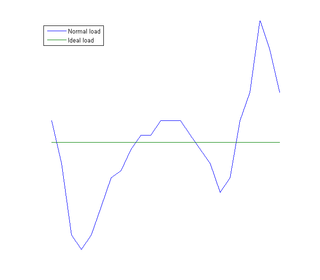
Scottish Power Limited, trading as ScottishPower, is a vertically integrated energy company based in Glasgow, Scotland. It is a subsidiary of Spanish utility firm Iberdrola.
Phoenix Natural Gas is the largest gas distribution business in Northern Ireland, being the owner and operator of the licence for the distribution network in the Greater Belfast area. The distribution business is responsible for the development of the pipeline network and also for providing a 24/7 operational and transportation service platform to suppliers under the rules of the company's network code. The ongoing investment within the Phoenix Natural Gas licence area does not attract any grant or support from local or UK government. The investment is a standalone private venture.
Public electricity suppliers (PES) were the fourteen electricity companies created in Great Britain when the electricity market in the United Kingdom was privatised following the Electricity Act 1989. The Utilities Act 2000 subsequently split these companies between distribution network operators and separate supply companies.
A Meter Point Administration Number, also known as MPAN, Supply Number or S-Number, is a 21-digit reference used in Great Britain to uniquely identify electricity supply points such as individual domestic residences. The system was introduced in 1998 to aid creation of a competitive environment for the electricity companies, and allows consumers to switch their supplier easily as well as simplifying administration. Although the name suggests that an MPAN refers to a particular meter, an MPAN can have several meters associated with it, or indeed none where it is an unmetered supply. A supply receiving power from the network operator (DNO) has an import MPAN, while generation and microgeneration projects feeding back into the DNO network are given export MPANs.

The Tanzania Electric Supply Company Limited (TANESCO) is a Tanzanian parastatal organisation established in 1964. It is wholly owned by the government of Tanzania. The Ministry of Energy and Minerals regulates the operations of TANESCO.
A virtual power plant (VPP) is a system that integrates multiple, possibly heterogeneous, power sources to provide grid power. A VPP typically sells its output to an electric utility. VPPs allow energy resources that are individually too small to be of interest to a utility to aggregate and market their power. As of 2024, VPPs operated in the United States, Europe, and Australia.
SP Manweb is the regional electricity distribution network operator (DNO) for Merseyside, North Wales and parts of Cheshire. It is now part of SP Energy Networks, itself a subsidiary of the Spanish energy company Iberdrola.

British Gas is an energy and home services provider in the United Kingdom. It is the trading name of British Gas Services Limited and British Gas New Heating Limited, both subsidiaries of Centrica. Serving around ten million homes in the United Kingdom, British Gas was the biggest energy supplier in the country, until 2024 when it was overtaken by Octopus Energy as the UK's largest electricity supplier. It remains larger for gas. It is considered one of the Big Six dominating the gas and electricity market in the United Kingdom. Their lines are open from 8am to 5pm on weekdays, and 9am to 6pm on weekends.
Economy 10 is the name of a tariff provided by United Kingdom electricity suppliers created in 2004. Similar to Economy 7 this is designed to be used with high thermal mass heating such as storage heaters, underfloor heating, and is also used with electrical boilers driving radiators or water-based heat stores.

Load management, also known as demand-side management (DSM), is the process of balancing the supply of electricity on the network with the electrical load by adjusting or controlling the load rather than the power station output. This can be achieved by direct intervention of the utility in real time, by the use of frequency sensitive relays triggering the circuit breakers, by time clocks, or by using special tariffs to influence consumer behavior. Load management allows utilities to reduce demand for electricity during peak usage times, which can, in turn, reduce costs by eliminating the need for peaking power plants. In addition, some peaking power plants can take more than an hour to bring on-line which makes load management even more critical should a plant go off-line unexpectedly for example. Load management can also help reduce harmful emissions, since peaking plants or backup generators are often dirtier and less efficient than base load power plants. New load-management technologies are constantly under development — both by private industry and public entities.
The electricity sector in New Zealand uses mainly renewable energy, such as hydropower, geothermal power and increasingly wind energy. As of 2021, the country generated 81.2% of its electricity from renewable sources. The strategy of electrification is being pursued to enhance the penetration of renewable energy sources and to reduce greenhouse gas (GHG) emissions across all sectors of the economy. In 2021, electricity consumption reached 40 terawatt-hours (TW⋅h), representing a 0.2% increase compared to the consumption levels in 2010.
In the United Kingdom, an electricity supplier is a retailer of electricity. For each supply point the supplier has to pay the various costs of transmission, distribution, meter operation, data collection, tax etc. The supplier then adds in energy costs and the supplier's own charge. Regulation of the charging of customers is covered by the industry regulator Ofgem.

Delhi Transco Limited (DTL), formerly Delhi Power Supply Company Limited (DPSCL) is the State Transmission Utility for the National Capital Territory of Delhi. It is responsible for the transmission of power at 220 kV and 400 kV level and for upgrading, operating and maintaining the high voltage network.
Electricity North West Limited is a British electricity distribution network operator, responsible for the administration and maintenance of the network, that distributes electricity to the North West of England excluding Merseyside and parts of Cheshire.

UK Power Networks (UKPN) is a distribution network operator for electricity covering South East England, the East of England and London. It manages three licensed distribution networks which together cover an area of 30000 square kilometres and approximately eight million customers.

Creos Luxembourg S.A. owns and manages electricity networks and natural gas pipelines in the Grand Duchy of Luxembourg. In this capacity, the company plans, constructs and maintains high, medium and low-voltage electricity networks and high, medium and low-pressure natural gas pipelines, which it owns or which it is responsible for managing.
Scottish and Southern Electricity Networks is one of two energy companies in the UK to be involved both in electricity transmission and distribution.

The Commission for Regulation of Utilities, formerly known as the Commission for Energy Regulation, is the Republic of Ireland's energy and water economic utility regulator.

Electricity Substation No. 269 is a heritage-listed electrical substation located at 36 Anglesea Street, Bondi, New South Wales, Australia. It was designed by Walter Frederick White, City Architect's Office and Municipal Council of Sydney and built in 1928 by the Municipal Council of Sydney. The property is owned by Ausgrid. It was added to the New South Wales State Heritage Register on 2 May 2008.










